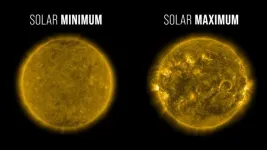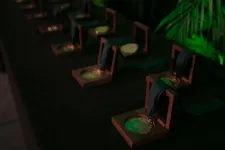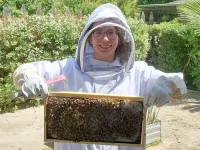(Press-News.org) In a teleconference with reporters on Tuesday, representatives from NASA, the National Oceanic and Atmospheric Administration (NOAA), and the international Solar Cycle Prediction Panel announced that the Sun has reached its solar maximum period, which could continue for the next year.
The solar cycle is a natural cycle the Sun goes through as it transitions between low and high magnetic activity. Roughly every 11 years, at the height of the solar cycle, the Sun’s magnetic poles flip — on Earth, that’d be like the North and South poles swapping places every decade — and the Sun transitions from being calm to an active and stormy state.
NASA and NOAA track sunspots to determine and predict the progress of the solar cycle — and ultimately, solar activity. Sunspots are cooler regions on the Sun caused by a concentration of magnetic field lines. Sunspots are the visible component of active regions, areas of intense and complex magnetic fields on the Sun that are the source of solar eruptions.
“During solar maximum, the number of sunspots, and therefore, the amount of solar activity, increases,” said Jamie Favors, director, Space Weather Program at NASA Headquarters in Washington. “This increase in activity provides an exciting opportunity to learn about our closest star — but also causes real effects at Earth and throughout our solar system.”
Solar activity strongly influences conditions in space known as space weather. This can affect satellites and astronauts in space, as well as communications and navigation systems — such as radio and GPS — and power grids on Earth. When the Sun is most active, space weather events become more frequent. Solar activity has led to increased aurora visibility and impacts on satellites and infrastructure in recent months.
During May 2024, a barrage of large solar flares and coronal mass ejections (CMEs) launched clouds of charged particles and magnetic fields toward Earth, creating the strongest geomagnetic storm at Earth in two decades — and possibly among the strongest displays of auroras on record in the past 500 years.
“This announcement doesn’t mean that this is the peak of solar activity we’ll see this solar cycle,” said Elsayed Talaat, director of space weather operations at NOAA. “While the Sun has reached the solar maximum period, the month that solar activity peaks on the Sun will not be identified for months or years.”
Scientists will not be able to determine the exact peak of this solar maximum period for many months because it’s only identifiable after they’ve tracked a consistent decline in solar activity after that peak. However, scientists have identified that the last two years on the Sun have been part of this active phase of the solar cycle, due to the consistently high number of sunspots during this period. Scientists anticipate that the maximum phase will last another year or so before the Sun enters the declining phase, which leads back to solar minimum. Since 1989, the Solar Cycle Prediction Panel — an international panel of experts sponsored by NASA and NOAA — has worked together to make their prediction for the next solar cycle.
Solar cycles have been tracked by astronomers since Galileo first observed sunspots in the 1600s. Each solar cycle is different — some cycles peak for larger and shorter amounts of time, and others have smaller peaks that last longer.
“Solar Cycle 25 sunspot activity has slightly exceeded expectations,” said Lisa Upton, co-chair of the Solar Cycle Prediction Panel and lead scientist at Southwest Research Institute in San Antonio, Texas. “However, despite seeing a few large storms, they aren’t larger than what we might expect during the maximum phase of the cycle.”
The most powerful flare of the solar cycle so far was an X9.0 on Oct. 3 (X-class denotes the most intense flares, while the number provides more information about its strength).
NOAA anticipates additional solar and geomagnetic storms during the current solar maximum period, leading to opportunities to spot auroras over the next several months, as well as potential technology impacts. Additionally, though less frequent, scientists often see fairly significant storms during the declining phase of the solar cycle.
NASA and NOAA are preparing for the future of space weather research and prediction. In December 2024, NASA’s Parker Solar Probe mission will make its closest-ever approach to the Sun, beating its own record of closest human-made object to the Sun. This will be the first of three planned approaches for Parker at this distance, helping researchers to understand space weather right at the source.
NASA is launching several missions over the next year that will help us better understand space weather and its impacts across the solar system.
Space weather predictions are critical for supporting the spacecraft and astronauts of NASA’s Artemis campaign. Surveying this space environment is a vital part of understanding and mitigating astronaut exposure to space radiation.
NASA works as a research arm of the nation’s space weather effort. To see how space weather can affect Earth, please visit NOAA’s Space Weather Prediction Center, the U.S. government’s official source for space weather forecasts, watches, warnings, and alerts.
By Abbey Interrante
NASA’s Goddard Space Flight Center, Greenbelt, Md.
END
NASA, NOAA: Sun reaches maximum phase in 11-year solar cycle
2024-10-15
ELSE PRESS RELEASES FROM THIS DATE:
Scientists at ChristianaCare gene editing institute use CRISPR tools to safely disable gene mutation linked to treatment-resistant melanoma
2024-10-15
Scientists at ChristianaCare Gene Editing Institute Use CRISPR Tools to Safely Disable Gene Mutation Linked to Treatment-Resistant Melanoma
Study finds CRISPR restores the ability for cancer treatments to attack melanoma cancer cells with precision-guided gene edit that ignores healthy cells
Wilmington, DE, OCTOBER 15, 2024 -- In a potential advance for melanoma patients, researchers at ChristianaCare’s Gene Editing Institute have used CRISPR gene editing ...
Study busts myths about cause of gout
2024-10-15
A major international study has found gout is a chronic illness where genetics is a major cause, rather than lifestyle choices of the sufferer.
Led by University of Otago researchers, the genome-wide association study, published in Nature Genetics, analysed the genetic information of 2.6 million people.
Researchers analysed amalgamated DNA data sets from around the world. About three quarters of the data was from customers of 23andMe, Inc, a direct-to-consumer genetics and preventative health company, who consented to participate in research.
They found inherited genetics is an important part ...
Machine learning analysis sheds light on who benefits from protected bike lanes
2024-10-15
A new analysis from University of Toronto Engineering researchers leverages machine learning to help answer a thorny question: where should new protected bike lanes be placed to provide maximum benefit?
“Right now, some people have really good access to protected biking infrastructure: they can bike to work, to the grocery store or to entertainment venues,” says Madeleine Bonsma-Fisher, a postdoctoral fellow in the Department of Civil & Mineral Engineering and lead author of a new paper published in the Journal of Transport Geography.
“More ...
New research reveals how large-scale adoption of electric vehicles can improve air quality and human health
2024-10-15
A new study from the University of Toronto's Department of Civil & Mineral Engineering suggests that large-scale adoption of electric vehicles (EVs) could lead to significant population-level health benefits.
The research team used computer simulations to show that aggressive electrification of the U.S. vehicle fleet, coupled with an ambitious rollout of renewable electricity generation, could result in health benefits worth between US$84 billion and 188 billion by 2050.
Even scenarios with less aggressive grid decarbonization mostly predicted health benefits running into the tens of billions of dollars.
“When ...
Florida Inventors Hall of Fame invites nominations for 2025 inductees
2024-10-15
TAMPA, Fla. (Oct. 15, 2024) -- The Florida Inventors Hall of Fame is inviting nominations for the 2025 class of inductees. This award recognizes distinguished inventors with a connection to Florida, whose achievements have advanced quality of life for the state and the nation.
“Inductees to the Florida Inventors Hall of Fame represent some of our nation’s greatest inventors from across academia, industry and government,” said Paul Sanberg, chair of the Florida Inventors Hall of Fame Advisory Board and president of the National Academy of Inventors. “Their achievements underscore the critical role that innovation plays in driving ...
Election officials can boost voter trust in delayed results with early communication
2024-10-15
In recent U.S. elections, results often took days to finalize, fueling voter distrust in the electoral process and ballot outcomes. Now, research from the Yankelovich Center for Social Science Research at UC San Diego shows that a simple, proactive message from election officials – ahead of Election Night – can effectively reduce this distrust.
The study, published in PNAS Nexus, reveals that when voters are informed in advance that counting ballots accurately takes time and there are security measures in place, their trust in the process remains steady, even when results are delayed.
“Election officials ...
Rice-led research will leverage responsible AI to enhance coastal communities’ severe storm response
2024-10-15
HOUSTON – (Oct. 15, 2024) – An interdisciplinary team of Rice University engineers and collaborators led by Jamie Padgett has won $1.5 million from the National Science Foundation (NSF) to improve the safety and resiliency of coastal communities facing compounded risk from hazardous weather events.
Padgett, together with Ben Hu and Avantika Gori at Rice, David Retchless at Texas A&M University at Galveston and community partners, will leverage responsible artificial intelligence (AI), hazard and resilience models ...
Honey bees in demand: New contract strategies to support pollination services
2024-10-15
URBANA, Ill. — As the world’s native bee populations are declining, crop production requiring pollinators increasingly relies on commercial pollination services. In the U.S., the beekeeping industry is in great demand, and truckloads of bee colonies travel the country to accommodate crop growers. A new study from the University of Illinois Urbana-Champaign looks at pollination contracts between beekeepers and California almond growers, exploring clauses that could make the agreements more appealing for both parties.
“There's about 1.3 million acres of almond trees ...
New climate change health research center under development at the University of Cincinnati
2024-10-15
Climate change presents far-reaching implications for the planet’s weather, sea levels, animals and food supply. Now experts are addressing climate change’s adverse effects on human health.
“We need to try to reduce risks for people, especially vulnerable populations,” said Ardythe Morrow, PhD, MSc, professor and director of the Epidemiology division of the Department of Environmental and Public Health Sciences at the University of Cincinnati College of Medicine.
To that end, the National Institute of Environmental Health Sciences of the National Institutes of Health has awarded a three-year, $4 million ...
Educational psychologists can play a part in fighting TikTok mental health and neurodiversity misinformation
2024-10-15
Educational psychologists could help to fight mental health and neurodiversity misinformation on TikTok as more young people self-diagnose based on poor quality content on the platform, a new study says.
Growing numbers of young people may be labelling themselves as being neurodivergent or having mental health conditions after engaging with information online, some of which may be inaccurate.
Educational psychologists and their professional bodies could engage with TikTok by creating accessible evidence-based content about neurodiversity and mental health on the platform.
Their assessments could also ...


